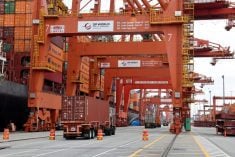Grain shippers have released their first weekly report on rail performance and the picture it paints isn’t pretty.
“Railways, CN and CP combined, have fallen short of shipper demand by slightly more than 11,000 hopper cars and approximately 200 box cars,” said Milt Poirier, partner in QGI Consulting and author of the report.
The exact accumulated shortfalls are 11,461 hopper cars and 199 boxcars through week 21 of the 2014-15 crop year.
The data comes from the first report of the Ag Transport Coalition, a group of agricultural organizations representing shippers of cereal, oilseed and pulse crops.
Read Also

Canadian trade data delayed by U.S. government shutdown
Canadian international trade data for September will be delayed indefinitely due to the ongoing partial shutdown of the United States government, Statistics Canada said Friday, Oct. 24.
“This group came together because of the tremendous lack of transparency in basic rail performance metrics on grain transportation in Canada,” said Wade Sobkowich, executive director of the Western Grain Elevator Association.
“Up until this point both government and the industry really only had railway data to rely on to benchmark performance metrics.”
The association will produce a weekly performance measurement report that will be made available for free to anyone who registers on the association’s web site (www.agtransportcoalition.com).
The first report is based on responses from “more than 15” shippers representing 70 percent of Western Canadian grain movement. In the coming weeks the stragglers will be added, bringing the total to 22 shippers representing more than 90 percent of grain rail shipments.
“We now have a robust and credible resource of quantitative data to ensure that a clear and complete picture of rail performance on grain transportation is available,” said Sobkowich.
The association hired QGI Consulting to gather, process and distribute the data on a weekly basis.
Poirier said the shortfall in hopper car supply amounts to 11 percent of the 106,647 cars shippers requested in the August through December period of 2014.
There is also a mounting problem with the timeliness of railcar delivery.
“What we’ve seen so far this year is that the railways are only supplying about 50 percent of the orders that shippers placed in the weeks that shippers are placing them,” he said.
Nearly half of all the unfilled orders have been outstanding for four weeks or longer. That makes it exceedingly difficult for shippers to co-ordinate grain buying in the countryside with vessel arrival at the ports.
The data shows the railways continue to focus on bulk corridors at the expense of grain movement to the United States and Mexico, traffic within Canada and pulse and special crops shipments through transloaders at ports in Montreal and Vancouver.
QGI is not tracking producer car shipments at this time or shipments of value-added products like canola oil and meal.
Dwell times will be another major focus of the weekly reports.
Poirier said shippers have a 24-hour window to load cars that have been dropped off by the railways before they face demurrage fees. They would like to see similar performance from the railways. But that isn’t happening.
Only 38 percent of the cars released by shippers to the railways for pick-up depart within that 24-hour window. And 30 percent of bulk grain shipments wait 48 hours or more once loaded and released to the railways.
The situation isn’t any better at the other end of the line. Destination dwell times, or the time between when a car arrives at a terminal and when it gets placed at a receiving facility for unloading, ranges from 30 to 55 hours for bulk commodities in Vancouver and about three to four times that long for pulses and special crops.
“There is a lot of volatility in that number week-to-week and cars are dwelling for long periods of time,” said Poirier.
Sobkowich said there were no surprises in the report, it simply reaffirms what grain shippers have been complaining about for years.
But now each shipper is able to compare their railway performance against an industry average. The data will also be used to lobby governments on railway reform.
Coalition members include the Canadian Canola Growers Association, the Alberta Wheat Commission, the Manitoba Pulse Growers Association, the Western Grain Elevator Association, the Canadian Oilseed Processors Association, the Inland Terminal Association of Canada, Pulse Canada and the Canadian Special Crops Association.
sean.pratt@producer.com















